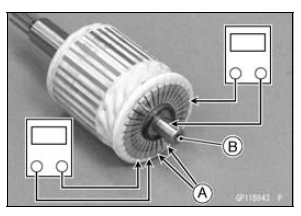

Special Tool - Hand Tester: 57001-1394
If there is a high resistance or no reading (∞) between any two segments, a winding is open and the starter motor must be replaced.
If there is any reading at all, the armature has a short and the starter motor must be replaced.

NOTE
Even if the foregoing checks show the armature to be good, it may be defective in some manner not readily detectable with the hand tester. If all other starter motor and starter motor circuit components check good, but the starter motor still does not turn over or only turns over weakly, replace the starter motor with a new one.
 Commutator Cleaning and Inspection
Commutator Cleaning and Inspection Brush Lead Inspection
Brush Lead InspectionReporting safety defects
(For Products Sold in the United States of America, District of Columbia,
and
U.S. Territories Only)
If you believe that your vehicle has a defect which could cause a crash or
could
cause injury or death, you should immediately inform the National Highway
Traffic
Safety Administration (NHT ...
Wheel Bearing Damage Inspection
Raise the front wheel off the ground with the jack (see
Front Wheel Removal in the Wheels/Tires chapter).
Special Tools - Jack: 57001-1238
Jack Attachment: 57001-1608
Turn the handlebar all the way to the right or left.
Inspect the roughness of the front wheel bearing by moving
[A] ...
Main Throttle Sensor Output Voltage Inspection
Measure the output voltage at the main throttle sensor in
the same way as input voltage inspection, note the following.
Disconnect the main throttle sensor connector and connect
the setting adapter [A] between these connectors.
Special Tool - Throttle Sensor Setting Adapter: 57001
-15 ...